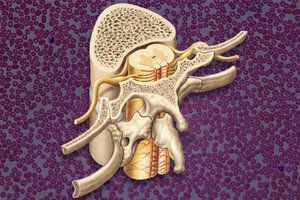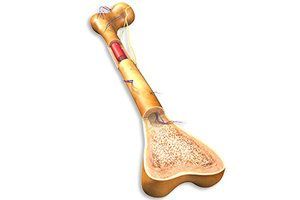Whether you accept it, avoid it or live somewhere in between, insurance coverage has become a defining issue for our profession. Patients increasingly expect to use their benefits, practitioners want to be compensated fairly for their time and expertise, and the system itself remains – at best – fragmented. The encouraging news is that coverage has expanded in meaningful ways. The challenging news is that reimbursement, across the board, remains inadequate.
Marrow: East & West
The NeiJing says, "If the Sea of Marrow is abundant, vitality is good, the body feels light and agile, and the span of life will be long. If it is deficient there will be dizziness, tinnitus, blurred vision, fatigue, and a great desire to lie down."
The Western view of Bone Marrow
Bone marrow makes up about four percent of your body's mass; it's the main site of new blood cell production or hematopoiesis, creating 500 billion blood cells per day. These new cells join the body's systemic circulation via permeable membranes within the marrow cavity of bone. The blood vessels of the bone marrow create a barrier which stops immature blood cells from leaving and only mature blood cells contain the membrane proteins required to attach to and pass the blood vessel endothelium and into the blood stream.
Red bone marrow, which is what children are born with, is a key element in blood cell production and of the lymphatic system, being one of it's primary organs in generating lymphocytes in combination with the thymus gland. Red blood cells, platelets and forms of white blood cells are made in the red marrow.
Yellow marrow, which increases with age and produces bone, cartilage, fat and certain forms of white blood cells, maintains its color due to the large number of fat cells it contains. If needed, the body can convert yellow marrow back to red if raising red blood cell counts is urgently needed, like during an injury or severe illness.
By adulthood, hematopoietic bone marrow, red marrow, is largely confined to the skull, vertebrae, ribs, clavicles and sternum, pelvis, and proximal femurs, the bones of the upper legs. Almost all of the bone marrow is yellow by the time a person reaches old age. Bone marrow also prevents the backflow of lymphatic fluid in the lymphatic system by serving a valve-like function.

The bone marrow stroma, or connective tissue that maintains the structure of marrow, contains mesenchymal stem cells (MSC) also known as marrow stromal cells. These are stem cells that can differentiate into a variety of cell types. MSCs have been shown differentiate into osteoblasts, chondrocytes, myocytes, marrow adipocytes and beta-pancreatic islets cells. Stem cell research is growing dramatically as the healing potential of these non-differentiated cells is explored for remedying many forms of illness and injury.
In addition to the actual bone marrow inside the bones, another source of bone marrow stem cells is in the blood that circulates in the veins and arteries of all normal people. Hematopoietic stem cells may cross the bone marrow barrier, and can be harvested from blood. These stem cells are known as peripheral blood stem cells (PBSC).
Bone Marrow: The TCM Perspective
The kidneys are the root of all pre-natal qi, just as the Spleen is the root of all post-natal qi. Anything considered genetic or hereditary in modern terms stems from the kidneys, as our ancestral information is stored there. Of the 6 Extraordinary Organs in Chinese Medicine, four are directly linked to the kidney: marrow, brain, bone, and the uterus. The other two are the Gall Bladder and the Vessels. Marrow, bone and brain, reflect of the condition of Jing in the body and interact and are interdependent upon one another.
In TCM we work with the concept of the 4 seas—the Sea of Qi, the Sea of Grains and Fluids, the Sea of Blood, and the Sea of Marrow, all storage areas in the body. Each can be identified by locations. The sea of marrow is located in the brain, spinal cord and bones.
The function of Marrow is to nourish the Brain and spinal cord and to form Bone-Marrow. Bone Marrow is thought to produce Bones and maintain their strength. TCM does not recognize that bone marrow produces blood as in Western thinking. It is Jing that feeds the kidneys and Marrow.
If these are deficient, the Bones lose nourishment, become brittle and cannot sustain the body. There will be inability to walk or stand. The teeth will crack and fall out (as aspects of bone). Likewise the brain and it's ability to concentrate and maintain intelligence, memory and to run the five senses will not be strong leading to poor memory/concentration, "empty" feeling in the head, dizziness, poor sense organ function, etc.

There are many correlations between East and West in understanding marrow and blood and the carrying out of Jing's purposes. For example, Jing plays a role in forming "clear blood," which translates as "plasma" in Western medicine. In modern physiology, the liver produces proteins that secrete into the blood, including major plasma proteins.
In researching the topic of marrow, blood and bone, I found no better way to demonstrate the merging of medicines than to share part of the abstract form the following study that I found on PubMed. "Studies conducted by our group on the mechanism of "kidney governing bones" theory in traditional Chinese medicine (TCM) are reviewed in this paper.
Conclusions can be summarized as follows: (1) Neuroendocrine-immune network (NIN)-osteoclast regulatory pathway OPG-RANKL-RANK is one of the mechanisms of "kidney governing bones." Although kidney-reinforcing therapy is regarded as one of the holistic regulatory mechanisms of the body, characteristic holistic regulation in TCM can be reflected through nonselective regulation of the NIN during kidney reinforcement therapy, which can be used to treat osteoporosis through microadjustments in the microenvironment of the bone marrow. (2) Marrow exhaustion in TCM, which is the state wherein lipocytes in the bone marrow increase whereas other cells decrease, serves as the pathogenesis of osteoporosis brought about by failure of the "kidney governing bones." (3) The kidney in TCM can be regarded as a complex system comprising multiple functional units in the body, including the unit "governing bones." Kidney deficiency refers to a deficiency in only one or more units of the kidney system and not the whole system itself, which explains the kidney-reinforcing effect of many herbs; some herbs can treat osteoporosis, but some cannot. Although both classified as kidney-reinforcing agents, the former can resolve failure of the "kidney governing bones" unit while the latter regulates the failure of other units in the kidney system. Despite the current understanding on "kidney governing bones" theory, the mechanism of "kidney governing bones" remains complicated and unresolved. Thus, further studies in this area are warranted."
As with all aspects of medicine, more research is required to find the correlations and overlaps between modern medicine and TCM. Hopefully someday we will be able to work together using the wisdom of both medicines, to conquer bone marrow related diseases.
Resources
- Ju D, Liu M, et al. Mechanisms of "kidney governing bones" theory in traditional Chinese medicine. Front Med, 2014 Sep;8(3):389-93.
- Lesser E. Marrow: Love, Loss and What Matters Most. New York: Harper Wave, 2016.
- Maciocia G."Simple Questions." In: A Comprehensive Text. London: Churchill Livingstone, 2015.



